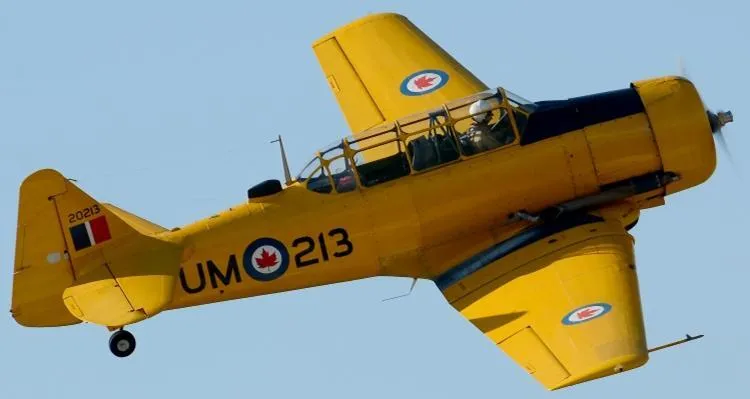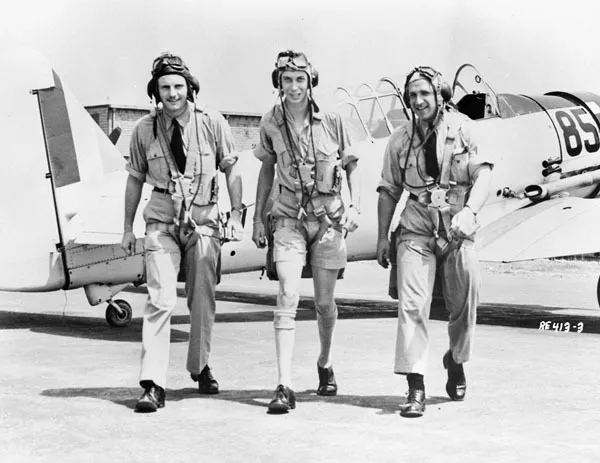![]() Harvards Above, A book about 31 Service Flying Training School - In Memoriam
Harvards Above, A book about 31 Service Flying Training School - In Memoriam
Beachcroft, Michael Melvill (Leading Aircraftman)
Killed in Flying Accident 1943-February-02


Birth Date: 1924
Born:
Parents: Son of Maj. Maurice Beachcroft O.B.E. and Mrs. Beachcroft, of Chalfont St. Giles, Buckinghamshire, England.
Spouse:
Home:
Enlistment:
Enlistment Date: unkown date
Service
RN FAA
Unit
31 SFTS- Service Flying Training School (RAF)
Base
RCAF Stn. Kingston, Ontario
Rank
Leading Aircraftman
Position
Service Numbers
FX90853
This incident involved multiple aircraft:
- Harvard Mk. II Serial: AJ645
- Harvard Mk. II Serial: AJ643
All the above aircraft in the above list are referenced in this report.
Crew or Other Personnel
Harvard AJ643
Harvard serial: AJ643

Canadian Warplane Heritage Museum
The North American Harvard appeared in 1937, in response to a US Air Corps proposal for an advanced trainer. The first of 50 Harvard Mk. Is ordered by the Canadian Government were delivered to RCAF Sea Island, BC in July 1939. By early 1940, the Mk. II was being assembled in California with an all metal fuselage replacing the original tube and fabric structure. 1200 Mk. IIs were supplied from US sources, until Canadian built Harvards started being produced in 1941.
In August 1938, Noorduyn Aviation of Montreal farsightedly signed an agreement with North American, to build the Harvard under licence. When the British Commonwealth Air Training Plan (BCATP) came into being in December 1939, Noorduyn received its first orders and went on to produce nearly 2800 Harvard Mk. IIBs for the RCAF and the RAF, between 1940 and 1945. In Canada, Harvard Mk. IIBs were used as advanced trainers with the BCATP at fifteen Service Flying Training Schools across the nation. They helped pilots make to the transition from low powered primary trainers, like Fleet Finch or the de Havilland Tiger Moth, to high performance front line fighters such as the Spitfire.
At the end of WW II, although the RCAF retained the Harvard as a trainer, a large number of them were sold off to civilian operators. The RCAF soon regretted this, for by 1949 the Cold War with the Soviet Union was in full swing and the RCAF urgently needed trainers again. 100 T-6J Texans were leased temporarily from the USAF and a further 270 Harvards, the Mk. IV version, were ordered from Canadian Car & Foundry, Thunder Bay. The RCAF used the Harvard Mk. IV for a further fifteen years, before finally retiring it in 1966.
A total of 20,110 Harvards were built between 1938 and 1954, 3,370 of them in Canada. Countless numbers of privately owned Harvards are still flying today.
Canadian Warplane Heritage Museum's Harvard Mk. IV was built by Canadian Car & Foundry, Thunder Bay, Ontario in late 1951. The aircraft saw service at four RCAF flying schools across the nation until it was sold to a civilian owner in 1965. It was the third aircraft to join the Museum after Dennis Bradley, Alan Ness and John Weir donated it in 1973. Canadian Warplane Heritage Museum
Aircraft Images
Harvard AJ645
Harvard Mk. II AJ645
Equipped with Dunlop pneumatic firing gear. Used by No. 31 Service Flying Training School at Kingston, Ontario. Ran into soft ground during precautionary landing on 15 November 1941, reported as undamaged "subject to detailed examination". To workshop reserve at No. 6 Repair Depot on 10 February 1943.1941-08-19 Taken on Strength No. 1 Training Command 2019-08-20
1943-February-02 Accident: 31 Service Flying Training School Loc: West Brook Names: Beachcroft | Paterson | Vickers | Walford
1943-04-14 Struck off Strength Struck off, reduced to spares and produce at No. 6 Repair Depot 2019-08-20
Harvard AJ643
Harvard Mk. II AJ643
Equipped with Dunlop pneumatic firing gear. Used by No. 31 Service Flying Training School at Kingston, Ontario. To Noorduyn Aviation on 10 February 1943 for crash repairs, to stored reserve with No. 1 Training Command on 28 April 1943. Issued from storage on 10 May 1943, probably back to No. 31 SFTS. To No. 3 Training Command on 19 February 1944, for records purposes only. To No. 8 Repair Depot at Winnipeg, Manitoba on 8 August 1944, for overhaul and modifications. To stored reserve with No. 2 Training Command when completed. To No. 2 Air Command on 1 December 1944, still in storage. Assigned to No. 206 Reserve Equipment Maintenance Satellite, Weyburn, Saskatchewan from 27 November 1945. Reported on 19 January 1948 as 2512:50 total time, 1200:00 since overhaul, condition fair, fitment standard, wings removed. To Training Command at Camp Borden, Ontario on 30 October 1950. To long term storage at No. 6 Repair Depot on 21 October 1953. To Aircraft Industries Limited from 4 February 1955 to 25 April 1956 for overhaul and modifications, including tail wheel de-clutch, rudder modification, and electrical junction box installation. To Training Command when completed. To stored reserve at RCAF Station Lincoln Park, Alberta on 18 July 1958. Pending disposal there from 1959. Sold to Alberta Government, for use as training aid at Southern Alberta Institute of Technology, Calgary. Still in use at SAIT in 2009, marked "11643".1941-08-19 Taken on Strength No. 1 Training Command 2019-08-20
1943-February-02 Accident: 31 Service Flying Training School Loc: West Brook Names: Beachcroft | Paterson | Vickers | Walford
1943-July-15 Accident: 31 Service Flying Training School Loc: No 1 Bombing Range Milhaven Names: Hemmings | Simpson
1944-July-28 Accident: 31 Service Flying Training School Loc: Aerodrome Names: Ambler | Gray
1960-03-09 Struck off Strength Struck off, to Crown Assets Disposal Corporation for sale 2019-08-20
Unit Desciption
31 SFTS (31 Service Flying Training School)
Graduates of the EFTS "learn-to-fly" program went on a Service Flying Training School (SFTS) for 16 weeks. For the first 8 weeks the trainee was part of an intermediate training squadron; for the next 6 weeks an advanced training squadron and for the final 2 weeks training was conducted at a Bombing & Gunnery School. The Service schools were military establishments run by the RCAF or the RAF.
There were two different types of Service Flying Training Schools. Trainees in the fighter pilot stream went to an SFTS like No. 14 Aylmer, where they trained in the North American Harvard or North American Yale. Trainees in the bomber, coastal or transport pilot stream went to an SFTS like No. 5 Brantford where they learned multi-engine technique in an Airspeed Oxford, Avro Anson or Cessna Crane.

For More information on RCAF Station Kingston see here
RCAF.Info - RCAF Station Kingston ON
RCAF.Info - Relief Landing Field Ganaoque ON